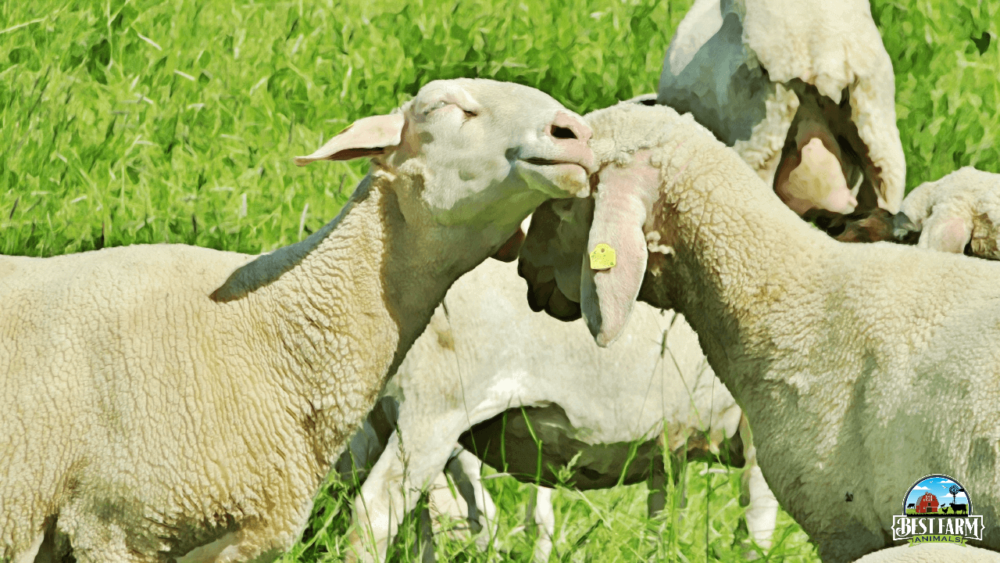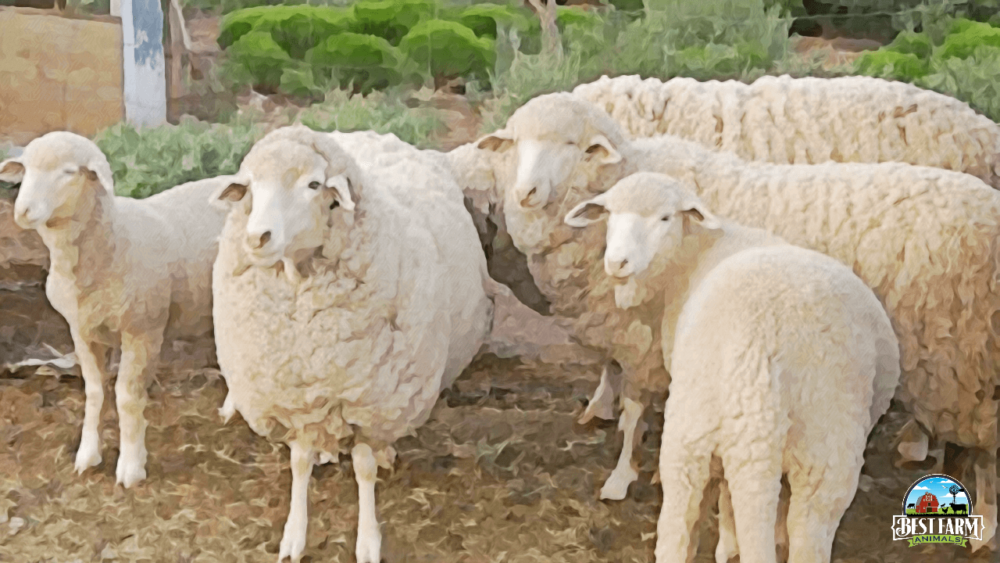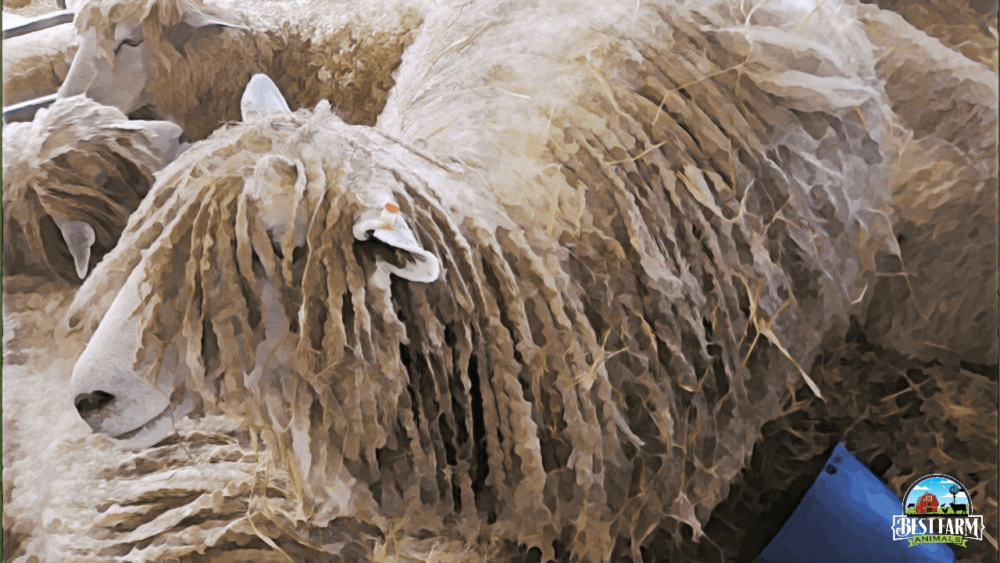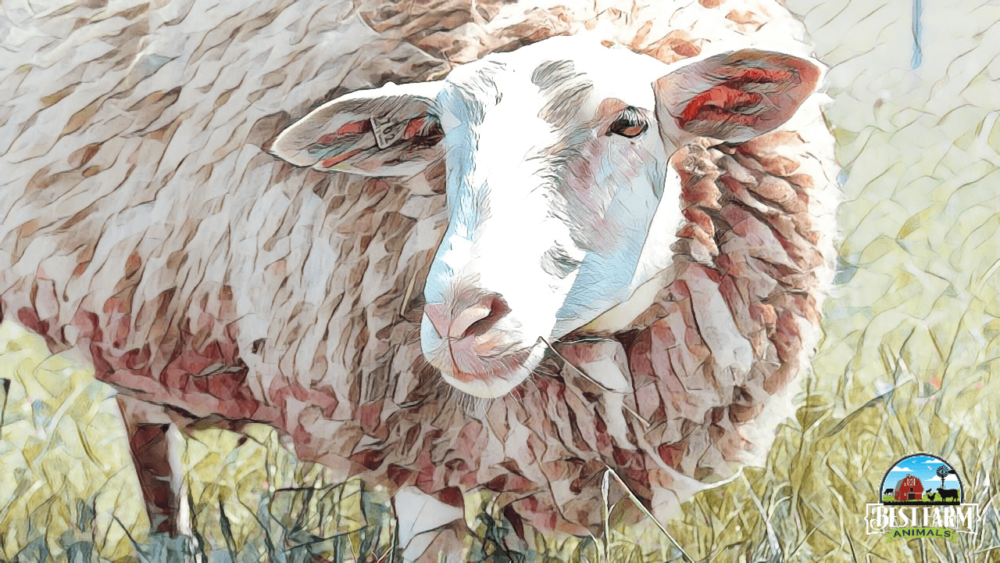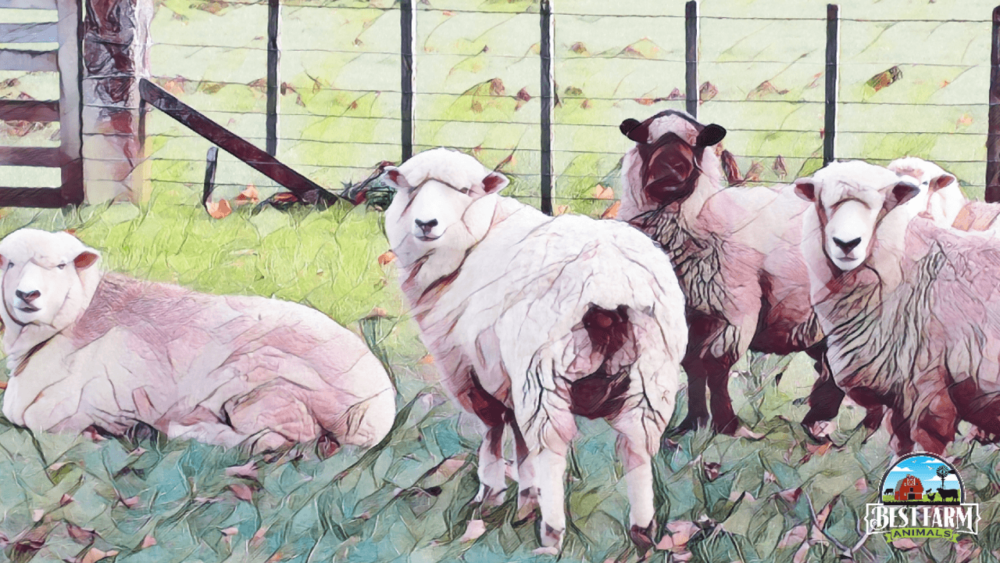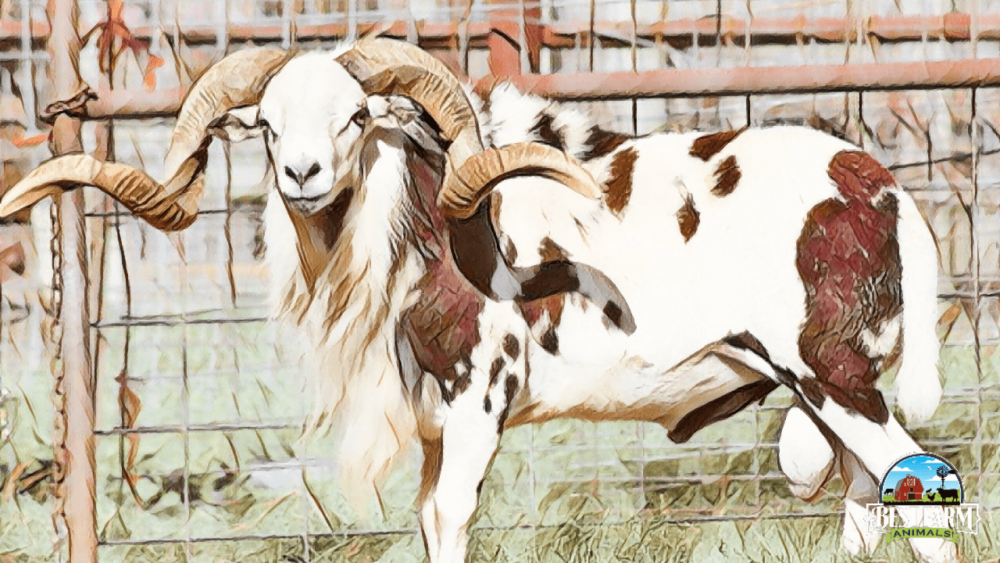One of the first animals to ever be domesticated by humans, the humble sheep has held an essential place in the history of livestock farming for thousands of years. With more than 200 unique breeds to choose from today, sheep come in various colors, including black, white, blue, brown, and combination colors. Both new and experienced livestock farmers will be able to find a breed that is perfect for their needs.
Solid white sheep have largely been the most popular coloration available for fiber production. This is because spinners can easily dye their wool to any hue needed for use in textiles. Additionally, white sheep can keep cool more easily in the summer as their white color reflects the sun’s heat instead of absorbing it.
Whether you are looking for sheep for milk production, meat production, or fiber yield, here are some of the best solid white sheep breeds available today!
White Sheep Breeds
Today there are many white sheep breeds, including Romney sheep, Texel, Merino, Rambouillet, Leicester, Cheviot, Fresian, Jacob, Painted Dessert, Lincoln, Dorper, Dorset, Islandic, and the Gaddi.
Some white sheep have black faces, others have white faces. Thill others white sheep breeds range in color from white to an off-white color. In fact, there are many white sheep breeds, which this article will cover in detail.
Texel Sheep
Originating in the Netherlands in the early 1800s, the Texel is a prevalent dual-purpose sheep breed. Imported into the United States in 1985, it took around 5 years before this naturally polled breed made it into the hands of private farmers. Once it did, its popularity grew at a steady pace.
Texel sheep produce an extremely lean carcass with a highly unique muscle structure. This makes them one of the best breeds for meat production in North America and Europe today. Texel rams are often used to improve the muscle quality in other breeds of utility sheep. They are used in experimental outcrossing and hybridization programs.
Texel sheep can be rather large, with ewes reaching 185 pounds (84kg) and rams reaching 240 pounds (109kg). However, their easygoing disposition makes them easy to handle and maintain. Texel sheep wool is all white or off-white, with no black hairs found in the collected fiber. They have all-white faces with black noses and hooves. Ewes can produce 11 pounds (5kg) of fleece at each shearing.
- Coloring: Pure white
- Face Coloring: White faces with a black nose
- Primary Uses: Wool and Meat
Merino Sheep
Originating in Spain in the Middle Ages, the Merino sheep is undoubtedly one of the best-known wool-producing sheep breeds in the world. While Merino sheep are almost exclusively used commercially for their wool, many small farms and operations worldwide specialize in Merino sheep meat.
This large-bodied breed can reach 180 pounds (81kg) for ewes and 235 pounds (106kg) for rams. Most Merino sheep are kept naturally horned; however, these horns are usually only seen in the rams. Variations of the Merino breed can be naturally polled, but most farms keeping Merino sheep will have them with horns.
Merino sheep are most commonly found in solid white, although Merino variations are found straw colored. Straw colored is often preferred to white-colored wool. Merino sheep have white faces, including white noses.
This sheep can produce massive amounts of wool at each shearing. It’s not uncommon for a Merino ewe to produce up to 40 pounds (18kg) of fleece annually. However, due to this fleece’s high amount of natural oils and grease, the usable percentage can be lower than in other breeds.
- Coloring: White to Straw colored
- Face Coloring: White faces (including noses)
- Primary Uses: Wool production (One of the highest wool-producing breeds in the world
Rambouillet Sheep
The first Rambouillet sheep started making their appearances in the late 19th century in France. Rambouillet sheep were created by mixing pure Spanish Merino sheep and various English wool-producing breeds. Over time, the Rambouillet became its own breed and quickly gained traction as a highly desirable Merino alternative.
Rambouillet sheep can be found both polled or horned. The most common coloring of Rambouillet sheep is white to creamy white wool. Rambouillet sheep can produce as many as eight colors of wool, including white, cream, black, silver, tan, and off-white variations.
Due to their horns’ unique and attractive look, many farms prefer to keep their rams horned and their ewes polled. Rambouillet sheep have exceedingly fine wool. Their wool is preferred for baby garments and next-to-the-skin clothing.
Rambouillet sheep can produce up to 15 pounds (7kg) of dense, long-fiber wool at each shearing. The usable percentage is excellent for such a large sheep. Additionally, the long fibers can be around 3 inches long. That makes this breed an excellent choice for hand spinners and wool crafting.
At maturity, Rambouillet ewes can reach or exceed 250 pounds (113kg), and rams can reach 300 pounds (136kg). Their large body size makes them an excellent choice for meat production as well. The mutton from a Rambouillet sheep is very tender compared to other breeds. The flavor is said to be intense but not overpowering.
- Coloring: Usually white or cream color
- Face Coloring: White faces, including white noses
- Primary Uses: Fine, soft wool
Leicester Sheep, Including Leicester Longwool
Created in the 1700s through selective breeding and outcrossing, the naturally hornless Leicester Longwool sheep is a unique and highly desirable fiber-producing breed. The wool on this breed is very long and has distinct curls for the entire fiber length. This makes it an excellent choice for hand spinners or those who use wool for various crafts and alternative textiles.
When sheared, a Leicester ewe can produce up to 20 pounds (9kg) of wool with an extremely high usable percentage rate.
Leicester Sheep are naturally colored sheep with white faces. Leicester Longwool are always solid white. Other Leicester sheep (not longwool) produce beautiful color variations, including white, cream, black, and silver. The Bluefaced Leicester is a newer coloring that shows off a face of grey and black.
Leicester sheep are called the “naturally colored sheep.” They are loved because their color fleece variations don’t need to be dyed. The wool is heavier yet extremely soft wool. The color variations make their wool a great choice for dyeing, Leicester Longwool sheep can also be found in black, brown, and various shades of those.
Adult ewes can reach 200 pounds (90kg) in size at maturity, and rams can reach or exceed 250 pounds (113kg). This breed is typically viewed as a single-purpose breed, focusing on their fiber production. Still, variations of the Leicester breed are equally as useful for mutton as well.
- Coloring: White or Cream colored. Black fleece is acceptable for Leicester sheep (not Leicester Longwool)
- Face Coloring: White-faced. A new Blue-Faced Leicester has recently been bred
- Primary Uses: Wool
Dorset Sheep: White-Faced Sheep
Extremely common worldwide for their dual purpose capabilities, the Dorset sheep was first brought to the United States in 1860. By 1885, it was exhibited for the first time at a livestock show in Chicago, Illinois, USA.
Dorset sheep are most commonly known for their exceptional meat qualities. However, the quality of their fiber is equally as useful with each sheep producing anywhere from 5 to 9 pounds (2-4kg) of wool per shearing. Dorset sheep have long bodies. They are either all-white or cream-colored. Their faces and hooves are also white. Their fleece is free from black fibers.
In the Dorset breed, the ewes can reach 200 pounds (90kg) and the rams can reach 275 pounds (124kg) in weight. Their muscle conformation produces a highly-desired carcass. They are most commonly found as polled stock, but horned Dorset are also preferred by many owners.
- Coloring: White or creamy-white
- Face Coloring: White-faced
- Primary Uses: Meat and wool
Cheviot Sheep
Found in various records in the late 1300’s, the Cheviot quickly spread worldwide as one of the top sheep breeds for fiber. Imported into the United States in 1838, then into Australia 100 years later. This hardy sheep breed has quickly made its mark regarding survivability and ease of care.
Cheviot sheep are white sheep with white faces. Their faces and feet are white and wool-free, but their muzzles are black. Their wool is long-stapled and 3.5 to 5 inches long.
Cheviots are usually kept for their wool, with each sheep providing up to 10 pounds of fiber per shearing. It is classified as a dual-purpose breed of sheep. Many owners find the Cheviot’s meat to be very mild and highly desirable in flavor.
Ewes commonly reach 160 pounds (72kg) and rams can reach 200 pounds (90kg) in weight at maturity.
The breed is almost always seen as polled stock. But, it is not unusual for some Cheviot sheep breeders to keep horned rams as breeding stock or exhibition animals.
- Coloring: Pure White
- Face Coloring: White-faced
- Primary Uses: Wool, but mean is becoming popular because of its mild flavor
Friesian Milk Sheep
Found as both the East Friesian and the Dutch Friesian variations. It depends on whether they originated in Germany or Holland. The Friesian Milk Sheep is known worldwide for its exceptional lactation abilities.
While a somewhat newer breed to the dairy sheep scene, the Friesian has quickly become the number one milk-producing breed of sheep in the world. Ewes can easily provide up to 600 liters of milk per 230 day lactation cycle, with the bulk of their milk being used in the commercial production of feta cheese.
Fresian sheep are almost always white colored and have a wool-free white face with pink noses. Some Fresian sheep can be found with black wool and black-faced, but this is rarer. They are polled or hornless naturally. The wool is medium coarse with fiber weights ranging from 8 to 10 pounds (4-4.5kg) per shearing.
The Friesian Milk Sheep is not usually considered to be a multi-purpose breed. But, their meat is often used on a smaller and non-commercial scale. It is said to be extremely lean with a mild and sweet flavor. They are extremely calm and friendly, making them great for pets.
In this large breed of sheep, the ewes can easily reach or exceed 200 pounds (90kg) and the rams can reach 275 pounds (124kg) in body weight at maturity.
- Coloring: White, although a black variation exists, but is rare.
- Face Coloring: White-faced with pink noses.
- Primary Uses: Milk
Jacob Sheep
Originally imported into the United States in the 1950’s, the Jacob sheep has been bred as both an ornamental animal and a fiber-producing breed for hand spinners, crafters, and small textile operations.
The Jacob sheep’s most unique trait is their horns, which both sexes display. Many animals have four horns, though two or six is not uncommon. Rams can display massive horns, with two curled around their ears, and two pointing into the air from atop their head.
Jacob sheep come in a fascinating blotched pattern with black and white being the most common combination. Their faces are almost always solid white, extending from their ears to their nose and dark wool around their eyes. You may have difficulty determining if a Jacob sheep is white with black spots or black with white spots.
There is no limitation to the type of spotted pattern this breed can have, and lambs are often born with extremely diverse color patterns on their body, face, and legs. Because of the distinctive color patterns in their wool, their fiber is highly sought after by weavers.
A Jacob sheep can produce up to 6 pounds (2.7kg) of fleece annually. They are considered a small breed. Ewes reach 110 pounds (49kg) and rams reach 160 pounds (72kg).
- Coloring: Black and white patterning
- Face Coloring: White noses and head with black around the eyes
- Primary Uses: Wool
Romney Sheep
Imported into the United States in 1904, the Romney quickly established itself as one of the best dual-purpose breeds of that time. Farmers found the naturally polled Romney breed excellent at converting less than perfect pasture into the right nutrients needed to produce lean and flavorful meat.
With ewes maturing at 200 pounds (90kg) and rams reaching or exceeding 275 pounds (124kg), the Romney is a desirable choice as a meat breed for both private and commercial-scale operations.
In addition, their wool is a very long fiber that is perfect for hand spinning. Each ewe sheared can produce around 12 pounds of fiber annually with an extremely high usable yield of 80% or more. Romney sheep wool is one of the most sought-after wools in the world. With the right genetics and quality, Romney wool often commands the highest wool prices.
Romney sheep have black feet and faces and a fleece that is usually silver or black. But they can also be pure white, shades of ivory, off-white colorations, and tan and brown color variations. The coloring depends on genetics and outcrossing. Lambs born to white parents can either be white or black and start developing their adult coloring by the time they are weaned.
- Coloring: White, Ivory, black, silver, tan
- Face Coloring: Black-faced
- Primary Uses: Highly sought-after wool
Painted Desert Sheep
Originally created using various breeds, including Mouflon, Texas Blackbelly, and Rambouillet. The Painted Desert Sheep is most commonly used for trophy hunting purposes.
However, in recent years, various ranches in the United States have focused on meat production within the breed. Painted Desert Sheep offers an exotic meat flavor without the gameness and stringy texture of wild species such as pure Mouflon.
Additionally, many ranchers find the Painted Desert Sheep to be extremely low maintenance when it comes to grazing and lambing. Painted Desert Sheep are attractive to hobbyists as well as to individuals looking for ornamental or exhibition breeds.
Painted Desert Sheep are white, cream, brown, and patterned. The most popular coloring is patterned with white, black and brown patterns. They are found in a mix of black, grey, brown and white coat patterns with a large white blaze on their face. Their color patterns are beloved by many. Patterns come in splashed, roan, or spotted patterns.
Being a hair sheep, this breed does not require annual shearing. Instead, they will naturally shed the undercoat during the summer months. On average, adult ewes of this breed can reach 120 pounds (54kg), and rams can reach or exceed 200 pounds (90kg) in weight.
- Coloring: Often very colored and patterned, but can also be found in white and cream colored variations
- Face Coloring: White-faced
- Primary Uses: Meat
White Sheep and Black Sheep Meanings
The term black sheep has come to refer to someone who rebels or goes against the expected normal or traditions of their family or culture. Because black sheep were rarer in many locations, they were considered an oddity. In the Middle East, a black sheep was considered a bad omen, while the European world saw black sheep as worse than the rest of the flock.
Traditionally, sheep were considered white, so when people refer to a sheep, they often expect a white sheep. Today, all-white sheep are often referred to as white sheep or simply sheep, while black sheep may still be referred to specifically as black sheep. But, the many sheep breeds native to many remote parts of the world have become mainstream breeds and widened the variety and beauty of the sheep available in most areas.
Conclusion
White wool is much easier to clean and dye for farms wanting a few sheep to produce fiber for hand spinning and home-based textiles. Additionally, solid white sheep may do better than other colors in sweltering climates because their white coat will reflect most of the heat.
My Essential Sheep Supplies
This list contains affiliate products. Affiliate products do not cost more but helps to support BestFarmAnimals and our goal to provide farm animal owners with accurate and helpful information.
This little giant bucket fits on a fence and this one’s easy to carry.
A sturdy dog collar is essential. Don’t do rope (they’ll break and tangle) or chain (injury!).
A Black Water Tub is way nicer than buckets that tip over. I like to get a 20 or 30-gallon in each pen so my goats have plenty of water, but you can get 100-gallons if you have a lot of sheep in one pen.
Loose minerals in a small bag or a Purina 50 lb bag, and a mineral feeder for free-choice is the best option. One side holds minerals, and the other holds baking soda. Don’t feed sheep goat minerals because it usually contains copper- something that is fatal to sheep.
Hoof trimmers are a necessity because you’ll need to trim your sheep’s hooves every few months. These are nice for the price.
Shearers like these aren’t too costly but do a decent job. Sheep wool jams normal shearers and once you are ready, I’d recommend the ones from Premier 1 Supplies.
Don’t make the mistake I made by waiting to order a drench gun before you need it. I was surprised by how often I use it. It helps with bloating, dehydration, and other ailments. Here’s a good drench, but you can also drench a bloat solution or water if dehydrated.
Digital Thermometor for when your lambs act sick. You’ll need to know if their temps are too low or too high so you can accurately diagnose the issues.
Vetericyn for wound care. It makes a big difference in a speedy recovery.
These heavy duty clips for fences, to clip ropes to collars, and a million other uses. They are stronger than carabeeners, which we broke a dozen of before switching to these.



